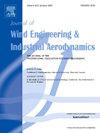沙漠光伏阵列风速廓线模型
IF 4.9
2区 工程技术
Q1 ENGINEERING, CIVIL
Journal of Wind Engineering and Industrial Aerodynamics
Pub Date : 2025-09-16
DOI:10.1016/j.jweia.2025.106239
引用次数: 0
摘要
准确预测光伏组件的积尘量对于提高沙漠光伏电站的发电预测能力至关重要。风廓线是估计作用在空气中颗粒上的流体力的关键工具,从而有助于理解光伏组件表面灰尘积聚的模式。鉴于该领域研究的稀缺性,本研究利用计算流体动力学(CFD)模拟来探索入射风速、光伏组件安装高度和倾斜角度对光伏阵列风廓线的影响。研究结果表明,摩擦速度和气动粗糙度随光伏阵列安装高度的升高呈s型增加,并随光伏组件倾角的增加而增加。基于这些见解,该研究开发了针对不同安装配置的光伏阵列量身定制的风廓线模型。模型建立了风速廓线与安装参数之间的函数关系。这些结果为利用理论模型预测光伏组件积尘量提供了重要的理论依据,为提高沙漠光伏电站发电预测精度提供了重要的科学支撑。本文章由计算机程序翻译,如有差异,请以英文原文为准。
Wind speed profile model of the desert photovoltaic arrays
Accurate prediction of dust accumulation on photovoltaic (PV) modules is crucial for enhancing power generation forecasts in desert PV plants. The profiles of wind serve as a crucial tool in estimating the fluid forces acting on airborne particles, thereby facilitating an understanding of the patterns of surface dust accumulation on PV modules. Given the scarcity of research in this domain, this study leverages computational fluid dynamics (CFD) simulations to explore how incoming wind speed, PV module installation height, and tilt angle affect wind profiles in PV arrays. The findings reveal that both friction velocity and aerodynamic roughness exhibit an S-shaped increase in response to the elevation of the installation height of photovoltaic arrays, as well as an increase corresponding to the tilt angle of the PV modules. Building on these insights, the study develops a wind profile model tailored to PV arrays with varied installation configurations. The model establishes a functional relationship between the wind speed profile and the installation parameters. These outcomes provide a vital theoretical basis for the prediction of dust accumulation on PV modules using theoretical models, thereby offering significant scientific support for improving the accuracy of power generation forecasts in desert PV power plants.
求助全文
通过发布文献求助,成功后即可免费获取论文全文。
去求助
来源期刊
CiteScore
8.90
自引率
22.90%
发文量
306
审稿时长
4.4 months
期刊介绍:
The objective of the journal is to provide a means for the publication and interchange of information, on an international basis, on all those aspects of wind engineering that are included in the activities of the International Association for Wind Engineering http://www.iawe.org/. These are: social and economic impact of wind effects; wind characteristics and structure, local wind environments, wind loads and structural response, diffusion, pollutant dispersion and matter transport, wind effects on building heat loss and ventilation, wind effects on transport systems, aerodynamic aspects of wind energy generation, and codification of wind effects.
Papers on these subjects describing full-scale measurements, wind-tunnel simulation studies, computational or theoretical methods are published, as well as papers dealing with the development of techniques and apparatus for wind engineering experiments.

 求助内容:
求助内容: 应助结果提醒方式:
应助结果提醒方式:


